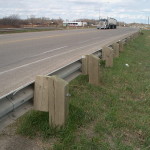Highway guard rail is one of the most well researched transportation devices. The height to which it’s installed, measured vertically from the pavement edge, is an important consideration. I’ve had to look this number up many times, and did so again to prompt me to write this article. So what is the correct height? Following […]
What is the Plastic Limit?
The plastic limit is defined as the moisture content at which a soil becomes plastic. It is the boundary between a soil’s solid and plastic states. ASTM D4318 is the standard test procedure for determining the plastic limit. Of course, a soil doesn’t go from solid to plastic all at once, but the standard test […]
What is the Liquid Limit?
The liquid limit of a soil is the moisture content at which: a soil changes to a liquid state. the boundary between the plastic and liquid states occurs. a soil loses its shear strength. Clearly a soil will not lose its shear strength all at once as water is being added, but there is a […]
What is the Shrinkage Limit?
The shrinkage limit of a soil is the moisture content at which: the soil is considered saturated. any loss of moisture will not result in any volume changes. The shrinkage limit is much less commonly used than the other Atterberg limits, the plastic limit and liquid limit. I have never seen the shrinkage limit reported […]
How to Draw Mohr’s Circle
Mohr’s Circle is used to graphically determine the principal normal and shear stresses. First, some definitions: Tensile stresses are positive. Compressive stresses are negative. Clockwise shear stresses are positive. Counterclockwise shear stresses are negative. To draw Mohr’s circle, and find the principal normal and shear stresses, you must know the stresses applied to the object, […]
What is Rock Quality Designation?
Rock Quality Designation (RQD) is a test used by geotechnical engineers to indicate the degree of fracture of a drill core. It is a simple process which involves counting up the pieces of drill core which are more than 10 cm long and fully intact. The percentage of the whole drill core length is the […]
How to Calculate the First Moment of Area
In structural engineering applications, the first moment of area is a calculation that is used to determine shear stress distributions. It is a relatively simple concept which involves the moment of a surface around an axis. $latex Q_y = x_c A\newline\newline Q_x = y_c A&s=2$ Where: Qx = first moment around the x axis (ft3 […]
Soil Particle Size Distribution
Soil contains four primary components, for engineering purposes: gravel sand silt clay Organic material can be present in surface samples as well but this has no relevance to engineering applications. Gravel and sand are classified as coarse-grained, whereas silt and clay are classified as fine-grained. Various classification schemes exist which attempt to define the grain […]
Pipe Standards
There are many different standards governing the different types of pipe material, diameters and wall thicknesses. The following are a list of standards in place in the United States: Gasketed PVC sewer pipe Smaller than 15 in. diameter: ASTM D3034. Greater than 15 in. diameter: ASTM F679. PVC pressure pipe for water distribution: AWWA C900. […]









